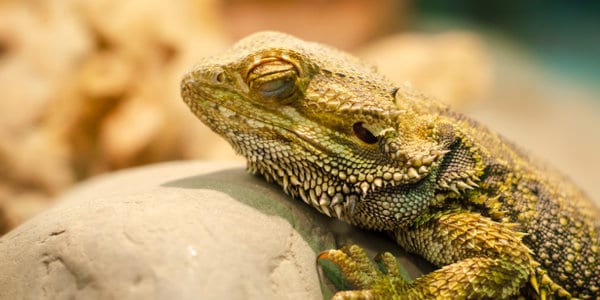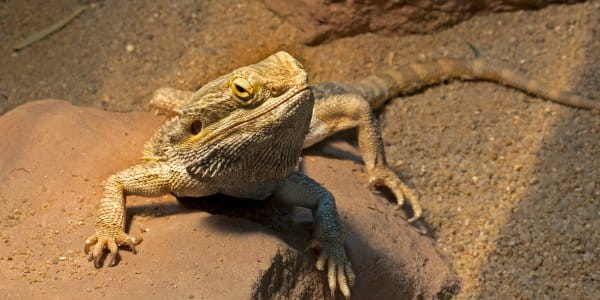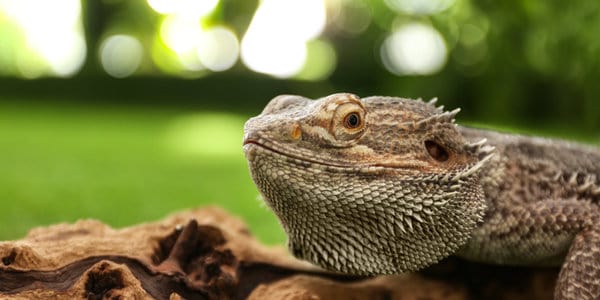Adopting a pet bearded dragon for the first time can be both exhilarating and confusing. It’s fascinating to set up the pet’s enclosure, feed the beardie, pet them for the first time, and watch them prance around the terrarium and explore their new surroundings.
Yet, if you’re like most newbie bearded dragon pet owners, chances are your pet dragon isn’t enjoying their sleep to the fullest despite all your preparations. Oftentimes, pet beardies’ sleep patterns are disrupted by inappropriate lighting cycles and arrangements.
Newbie and other inexperienced bearded dragon owners are eager to know whether their reptile companions need lights to be on at night for cozy sleep. So, can bearded dragons sleep with lights on? Naturally, bearded dragons can’t sleep with lights on. Like humans, beardies are diurnal (active during the day and turn in after dusk) creatures.
Moreover, their perpetual (third) eye perceives even dim lights, shadows, and almost imperceptible movements above the beardie. Thus, bearded dragons sleep best in complete darkness.
Bearded dragons are akin to human beings in many ways. They’re not only diurnal and omnivorous (feed on both plant matter and animal products) but also sleep facing down alongside other queer sleeping positions.
Fortunately, understanding your pet bearded dragon’s sleeping requirements, behaviors, and patterns helps you to give them the best care for a comfortable, healthy, and blissful life.
Read on to learn the various circumstances that compel some pet bearded dragon owners to consider light useful for their pets’ sleep and health at night.
On top of this, we’ll explore the best lighting arrangement and cycles to guarantee your pet beardie sufficient and relaxed sleep at night for an all-round healthy, active, cheerful, and long life.

What happens if I leave my bearded dragons light on all night?
Put simply, your beardie pet would find it impossible to sleep with their terrarium light on at night. Since bearded dragons are diurnal, their natural sleep-wake cycle dictates that they stay awake and active during the day and turn it at night.
Leaving a bearded dragon’s light on at night disrupts the lizard’s normal waking and sleeping patterns. This means your pet will be unable to sleep at night when they should. Instead, you might find them sleeping off during the day to compensate for the lost sleep.
On top of this, consistent lack of sufficient sleep results in multiple other beardie complications such as excessive lethargy, abnormal inactivity during the day, a dwindling appetite, and serious health complications such as metabolic bone disease (MBD).
But possibly the worst consequence of consistent sleep deprivation in beardies is that it might eventually cause your beloved pet to die early.
Do Bearded Dragons Need their Lights On at Night?
Here’s the simple answer: No! Bearded dragons don’t need their lights on at night. Leaving the terrarium lights or other extraneous lights on at night confuses a beardie into thinking that it’s still day-time.
When a beardie’s normal sleeping-waking clock is interrupted, the dragon naturally stays awake and active as they would during the day. This might result in numerous complications in a pet bearded dragon’s health, mood, and general behavior.
Nevertheless, it’s a little more intricate than that. Multiple factors influence a beardie’s typical day-night cycle as we’ll establish shortly.
Consider the Conditions in your Pet Beardie’s Natural Habitat
When trying to figure out whether a pet bearded dragon needs light at night, it’s crucial that you first consider the conditions under which the reptiles thrive in the wild. Bearded dragons originate from the arid Australian Desert, Outback, and Woodlands.
Typically, these areas receive plenty of sunshine during the day throughout the year but cool off at night.
During the warm summer and spring seasons, the natural beardie habitat receives approximately 12-14 hours daily, sometimes clocking up to 16 hours of natural sunshine. On the other hand, the area receives roughly 8-12 hours of natural sunlight during the colder winter and autumn seasons.
At night, the natural beaded dragon habitat stays pitch dark except for the stars. Ideally, the cooler and dark conditions enable the reptiles to rest and sleep peacefully.
Ideal Conditions for a Beardie’s Artificial Habitat
Like their wild counterparts, captive bearded dragons require plenty of sunshine during the day and cooler conditions at night to survive and thrive. That’s why you need to replicate the conditions in their natural habitat in your beardie’s tank.
However, it’s unlikely that your pet dragon will receive sufficient natural sunlight in their enclosure as the light is blocked, absorbed, refracted, or reflected away by various terrarium components such as the terrarium walls.
Therefore, you need to supplement natural sunlight with artificial lighting to ensure a caged beardie stays active, healthy, comfortable, and happy. Mostly, artificial lighting in a beardie’s tank is designed to supply either light, heat, or both.
You don’t want to miss this: To sufficiently mimic a beardie’s natural habitat’s temperature, you need to keep their tank lights on for 12-14 hours during the day and then switch them off at night for the nest 12 hours. On the other hand, the tank lights need to stay on for 8-10 hours during the colder winter and fall seasons to keep your beardie pet sufficiently warmed up.
Then again, you’ll want to keep your pet dragon’s tank cooler and completely dark at night during the hot and cold seasons to allow the lizard to rest and sleep well.
On top of this, it’s recommended to turn the tank lights on for about one hour prior to and after feeding your bearded dragon companion. Essentially, this process cranks up the lizard’s appetite and ensures the ingested food and supplements are digested and absorbed efficiently.
Why is Appropriate Lighting Crucial to a Bearded Dragon?
Bearded dragons require sufficient and consistent lighting to grow and stay healthy. They are ectothermic or cold-blooded, meaning they rely on the temperature in their surroundings to regulate their body temperature (thermoregulation). That’s why beardies need to take in radiant heat from external sources of heat and light such as the sun.
Typically, a full-spectrum ultraviolet light source is the recommended choice for lighting bearded dragon tanks. The beardie absorbs the ultraviolet-A (UVA) and ultraviolet-B (UVB) rays from the sun or other full-spectrum UV light.
It gets more interesting: The UVB light absorbed by a beardie supplies vitamin D3 which in turn fosters effective digestion and calcium absorption.
Ideally, supplying the recommended amount and duration of UVB exposure to a beardie pet helps to prevent hypocalcaemia (calcium deficiency) and hypercalcaemia (excessive calcium) in the lizard’s body.
As a result, your pet beardie enjoys wholesome bone formation, strong cardiovascular and immune systems, healthy muscle development, and an overall healthy body and jovial being.
That’s not all. Appropriate lighting arrangements for a bearded dragon should cover at least two thirds but not the entire tank.
You should not illuminate part of your bearded dragon’s enclosure to allow it to stay cooler than the other parts of the tank. Habitually, your pet will move to this cooling spot whenever they want or need to cool off their body.
The Circadian Rhythm
Circadian rhythms refer to the mental and physical changes that influence an animal’s behavior in a 24-hour cycle. Typically, circadian cycles in bearded dragons are influenced by the tank and surrounding light and darkness.
Here’s a valuable fact to take home: Circadian cycles in caged bearded dragons impact vital body and mind functions such as hormonal excretion and normal sleep-wake cycles. Consequently, these functions affect your pet’s mental condition and general morale.
In most instances, a bearded dragon pet’s circadian rhythm is interfered with by inappropriate lighting cycles, especially keeping the beardie tank’s light on at night. When this happens, your beardie friend either sleeps off their normal schedule or doesn’t receive sufficient sleep for healthy living.
But probably the worst thing about invading a beardie’s circadian rhythm is that it causes your pet undue mental imbalance and physical stress as they’re unable to sleep normally.
On top of this, vital hormones aren’t released when and as they should be, resulting in multiple health, behavioral, and mood discrepancies that impact your pet’s overall wellbeing drastically and negatively.
Here’s the good news: Creating an artificial habitat for your beardie pet with lighting and heating arrangements and cycles that resemble the lizard’s natural habitat enables them to maintain their natural biological clock (circadian rhythms).
As a result, hormones are released optimally and the dragon enjoys their nightly sleep to the fullest.

Do Bearded Dragons Need Complete Darkness to Sleep?
Absolutely! Like their wild counterparts who sleep under pitch darkness in the Australian desert and outback, caged bearded dragons need complete darkness to sleep at night.
Remember the reptiles interpret any form of light as daylight, and proceed with most of their daytime exploits such as playing and eating.
For this reason, you should avoid leaving any light (white or colored) on in a bearded dragon’s enclosure at night as it would irritate the pet’s eyes and throw the dragon off their circadian rhythm.
Then again, there are a few exceptional situations where the temperatures inside or outside your bearded dragon friend’s terrarium fall extremely low and leaving a beardie’s tank on at night might be necessary. They include:
- When it’s freezing or extremely cold during winter
- Being geographically located in an area that’s naturally extremely cold
- When your beardie’s tank stays in a particularly cold part of the house such as the basement.
In all the above cases, keeping the lights on in the pet’s tank for some time might supply the right amount of heat to sufficiently warm up your beardie for cozy sleep. Nevertheless, that would disrupt their circadian rhythm and normal sleeping patterns.
But all is not lost. An ideal way to resolve such situations without causing your dragon any further discomfort is to use a ceramic heat emitter (CHE) or under-tank heat mat.
Such appliances supply enough heat to sufficiently warm up a beardie’s cage without producing light that would distract the reptile’s sleep.
Possibly the best perk of a CHE over a heat map is that it doesn’t carry the risk of causing thermal burns to your precious pet as the latter.
Still, it’s critical that you obtain a ceramic heat emitter with the correct wattage to warm up your beardie without supplying excessive heat that could harm your pet or cause electric fixtures to catch fire.
Frequently Asked Questions
Do Pet Bearded Dragons Require a Heat Lamp at Night?
No. Contrary to a common misconception, captive beardies don’t need a heat lamp in their enclosure at night as they sleep more comfortably when it’s cooler (between 65 and 80° Fahrenheit) than during the day.
Nonetheless, you’ll want to install a suitable heat lamp such as a ceramic heat emitter or under-tank heat mat to warm up the terrarium if the temperatures in the tank and room fall below 65° Fahrenheit (approximately 18° Celsius).
Should You Switch off a Beardie’s Tank Lights at Night?
Yes, it’s recommended to switch off all bearded dragon lights at night to enable your pet to relax and sleep properly. Any form light (colored, bright, dim, stable, or flickering) confuses a bearded dragon into believing that it’s still daytime while in reality it’s at night.
As a result, the reptile’s circadian rhythm and normal sleep schedule veer off the track and might cause multiple grave beardie complications such as sleep deprivation, loss of appetite, lethargy, abnormal weakness, MBD, and possibly lead to untimely death.
Still, it’s important to leave the lights on temporarily (approximately one hour) before and after feeding to improve appetite and digestion respectively.
How Long Should a Beardie Tank’s Lights Stay on?
Typically, bearded dragons require around 8-12 hours of sleep day for healthy and happy growth and all-round wellness. Thus, you should replicate their natural habitat and living patterns in their tank as closely as possible.
This means you should leave the tank lit for 8-14 hours during the day and switch off the lights for approximately 12 hours before switching them back on again.
When a beardie acquires consistent and sufficient sleep daily, they enjoy all-round healthy growth, a generally jovial disposition, and a habitually active lifestyle. Remember: a happy pet makes a contented pet owner.
When Do Bearded Dragons Sleep?
Beardies are diurnal beings, so they habitually stay awake and active during the day and sleep when dusk falls. Thus, it’s recommended to switch off all beardie tank lights off at night to allow the dragon to slow down their metabolic processes, relax their body and mind, and sleep.
Should You Cover a Beardie’s Tank at Night?
Although it’s not the best approach to concealing external lights from flooding through to the beardie’s tank, covering the top sometimes does the job beautifully and helps to regulate temperatures inside the enclosure.
However, you risk limiting free air flow into and out of the terrarium and that might impact your pet negatively.
The best recommended way to keep extraneous lights out of a bearded dragon’s enclosure is by installing shades over them or switching them off completely.
In case you resort to covering the terrarium, ensure you uncover it promptly after sunrise to ensure your dragon enjoys sufficient light.

Wrapping Up
While beardies share numerous traits with humans, they possess a few unique albeit queer behaviors that set them apart as a fascinating species. For instance, bearded dragons clearly can’t enjoy comfortable and sound sleep with lights on.
Keeping any form of light on in the reptiles’ tank at night only disrupts their circadian rhythm and regular sleeping cycle.
It gets worse: Interfering with a bearded dragon’s normal sleep pattern deprives them of sufficient sleep. Consequently, the pet might suffer multiple grim tribulations such as irregular hormonal release, metabolic bone disease, extreme lethargy, and could even die prematurely.
Fortunately, using alternative heat sources like under-tank heat mats and ceramic heat emitters enables beardie pet owners to crank up the tank temperatures back to the norm without producing light that would irritate the beardie.